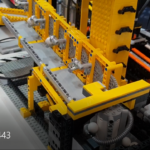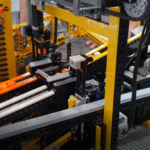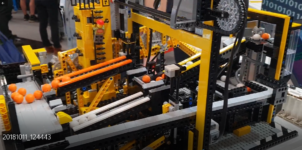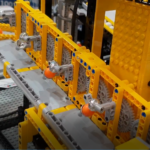Industry 4.0 Demonstrator
Cybersecurity And Manufacturing
If you are interested in this or similar installations, please contact us via our contact form, or give us a call at +49 (176) 6984 5733.
In 2018, Ernst & Young commissioned an installation which simulates an industrial manufacturing process. To demonstrate the vulnerability of modern industry 4.0 manufacturing facilities to cyberattacks, the machine had to allow interfering with or manipulating it. The goal was to demonstrate the need for effective cybersecurity measures.
The installation was first displayed by EY on their booth at the IT security fair it-sa in Nuremberg, Germany, in October 2018. The setup was a great success with EY and their visitors, and has been used numerous times for training and visualization purposes within and without the company.
8millimeter realized the machine using Lego Technic™ and the programmable robotics system Mindstorms®. EY created the software and hardware setup necessary for manipulating the machine’s firmware, and thus its functioning, in real time. The Mindstorms firmware brick has a USB port, and this was used to communicate with it via a WLAN connection. The installation therefore needed no cabling except for its own power supply, so that the cyber threat posed by an external attacker could be demonstrated in a credible fashion. Finally, a WLAN sniffer was used, a device which can interecpt and also manipulate traffic sent through a wireless connection. This completed the setup of a cyber attack scenario.
The continuous manufacturing process is simulated by the machine’s two basic functions. Orange and white plastic balls are transported in a loop via several conveyor devices. In the machine’s center, the balls are sorted by color, the correct sorting representing the correct output of the manufacturing facility. In real life, a plant’s correct output would be parts or systems assembled correctly, or pharmaceuticals correctly produced, labelled, or packed. Especially with pharmaceuticals, one can imagine that any mixup affecting labelling, sorting, or potency can have literally lethal effects.
There are several options to manipulate the machine. The easiest one is to stop the process – denial of service. An attacker could, however, also want to destroy the facility. As instructions can be sent to the the robotics element in real time, this could be achieved by sending extreme commands to the motor control which result in the destruction of the motors. Everybody agreed that this scenario would not be demonstrated at the fair! The most impressive attack, finally, made the sorting work the wrong way: the orange balls would end up in the receptacle cache for the white ones, and vice versa. This was the scenario which EY’s consultants ran for their booth visitors most often. Imagine what it would mean in real life if insulin left the plant in packaging stating the wrong type or potency…
Both as an eyecatcher and as a functional requirement, the machine has a variety of conveyor and lifting devices. On their journey through the “plant”, the balls are first lifted to the top by an Archimedean screw and fed to the color sensor. A picker then drops them into their respective collector through. After sorting has been completed for a full batch, the through is pushed upwards by a lift frame, and the balls dumped into a collector bin, where they mix again. For the transport back to the initial screw lift device, there are two options. If the rocker slide into which the balls are fed from the cache is tilted to the left, the balls will be conveyed to a see-saw basket device which transports them upwards one-by one. In case of a malfunction is this delicate device, the rocker slide can be tilted to the right. The balls are then emptied into a simple slide on which they roll backwards to the starting pool. The cycle then begins anew.
The demonstrator is replete with devices for safe operation and transport. The machine itself sits in a tray which collects any stray balls. The bed-plate is fitted with slanted positioning wedges so that the machine automatically slides into the right position when it is placed on the tray. For the entire assembly, a high-quality transport case, similar to the boxes in which music equipment is transported, has been made available.








